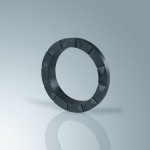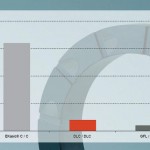Operators of high-quality pump systems know that dry running usually involves severe damage to the mechanical seals and bearings. The starved lubrication also affects other pump components. A specially developed surface coating in the form of a graphite film lubricant ensures that the critical first run takes place smoothly, even with lengthy start-up under dry-running conditions.
Why does dry running damage a pump? The process fluid performs two important functions for the mechanical seal. Firstly, it acts as a coolant, removing the heat caused by friction of the mechanical seal. Secondly, the process medium is responsible for forming a stable lubricating film, which minimises friction between the sliding surfaces and prevents excessive temperatures. If the process fluid fails, the lubricating film can break down completely within a very short time, depending on the materials of the sliding surfaces. The sliding surfaces heat up rapidly and damage the mechanical seal irreparably. The bearings suffer a similar fate. Lengthy operation is also harmful for closed valves in the pressure line – the process fluid quickly heats up to temperatures that are critical for me- chanical seals and sliding bearings (hot running).
A pump is most vulnerable to dry running during the (initial) start-up phase. To increase the dry-running tolerance in this phase and at the same time provide an inexpensive alternative to conventional diamond-like carbon (DLC) coatings, ESK has developed a graphite film lubricant (GFL) for mechanical seals and bearings. The principal advantage of this coating is that it can be easily applied in different ways according to requirements. The coating has no environmental impact. In numerous practical tests, it has been shown that the graphite film lubricant allows the seal pairing to withstand even extended dry running during initial operation. This is because of the significant reduction in the friction coefficient and consequently frictional heat. Unplanned critical states (cav-itation, too much gas in the fluid or too little process fluid) can occur at any time during operation. Such operating states can never be completely avoided in practice and the materials used must be capable of coping with them. It is therefore all the more important to use the most wear-resistant mechanical seals and sliding bearings pos-sible.
Tailored solution
A suitable SSiC material must be selected not only according to operating requirements but also based on the process fluid that is handled. ESK’s engineers pick the ideal material from a wide range of EKasic products. With seven specialised SSiC materials to choose from, they can develop a tailored solution for any challenge.
A typical practical example is the exploitation of new gas and oil reserves, where production companies penetrate into ever deeper regions with correspondingly higher temperatures and pressures.
Pumping the highly abrasive and corrosive oil-sludge mixture out of the borehole requires particularly resistant, high-performance pumps. Working closely with the pump manufacturer, ESK developed a bearing system of coarse-grained EKasic C. This ceramic is inherently resistant to tribocorrosion and abrasion. By optimising the component design for ceramics, the pump manufacturer can promise customers increased performance with longer service lives.
Apart from the resistance of the components, the materials are also chosen according to ultimate load and energy consumption considerations. In this respect, it is worthwhile investing in more efficient ceramics. For example, compared to EKasic C, energy consumption can be reduced by up to 50 % if graphite-containing EKasic G is used. Another example of a so-lution to specific customer requirements comes from the shipping industry. The continual increase in the pumping rates of tank-emptying pumps meant that one customer was faced with repeated pump failure. Faster pumping rates mean shorter unloading times in the harbour, which saves costs. However, pump downtimes result in huge costs in just a short time due to demurrage charges. After a detailed analysis of the loading conditions, EKasic G was chosen as the bearing material in this case. Yet ultimately it was the combination of material and surface engineering that brought the desired success. To receive the high pv values (pv = contact load for a defined sliding velocity), the axial bearings were laser engineered to provide hydrodynamic lubricating pockets. Dimples were selectively introduced into the surface by laser ablation.
This created tiny lubricant reservoirs and reduced friction and wear. The introduction of intelligent structures generates lift between the sliding surfaces. This assures an optimum sliding film even at high axial pressures. The pumps have operated reliably and energy efficiently since this combination was introduced.
Online-Info www.cpp-net.com/2309408


cpp: Mr. Schweizer, how closely do you cooperate with pump manufacturers? Are you involved in the early design phase of a pump?
Schweizer: Ideally, we would be included in the design study for the selection of the material. On request, we help pump designers choose designs that are appropriate for ceramics – for example using finite element modelling to reduce mechanical and thermal load peaks. That minimises the risk of component failure. At this early stage, it can be advisable to talk about particular surface structures and coating techniques. As always, mistakes at the design stage are difficult to compensate for later.
cpp: Do pump operators ever approach you directly because of service life problems?
Schweizer: Yes, quite often. An ESK customer support engineer then assists the operator with selecting the right materials. We also offer failure analysis and materials analysis as a service. However, producing customised individual parts is not generally economical for the end user.
cpp: You coat ceramics, modify their structure and engineer the surfaces by laser – what else do you have in your development pipeline?
Schweizer: Our development activities are clearly influenced by trends in the pump industry. Pump operators require high temporal and functional availability together with reduced energy input. Sustainability is generally increasing in importance. We are currently working on extending our materials range with new complementary material types, and continually improving the material properties. The goal is always either to improve performance for the same energy input or to reduce energy input for the same performance.
Share:








